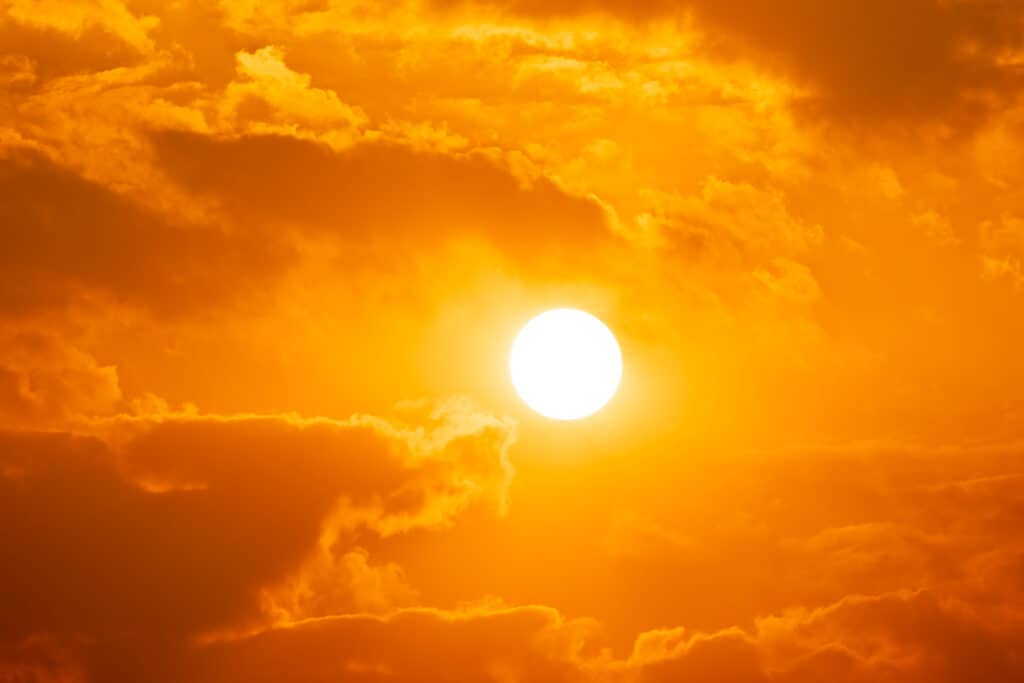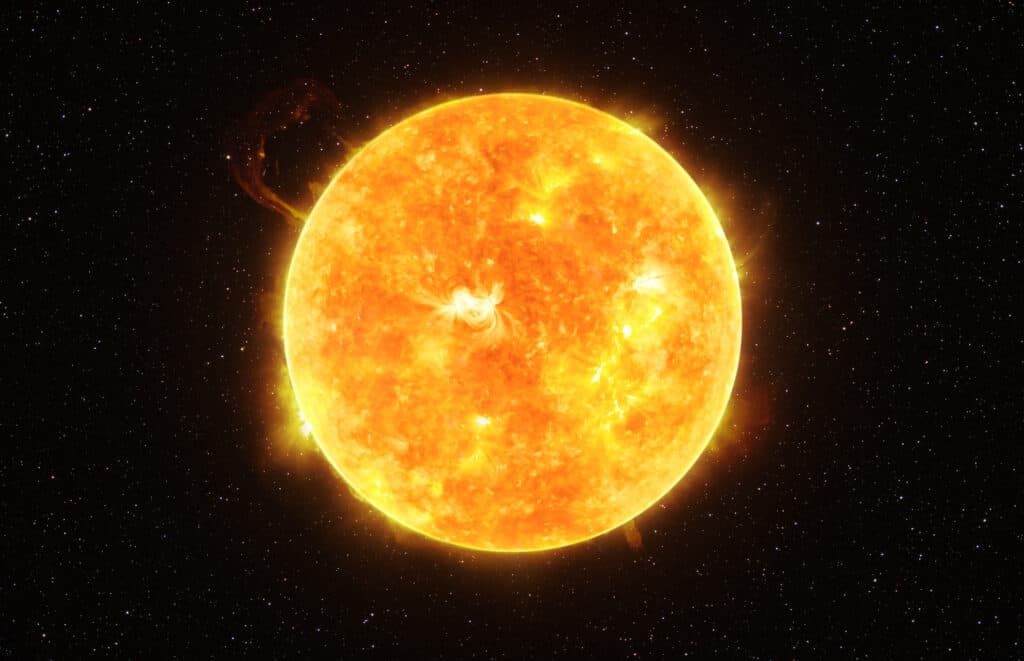We all know what the sun is; it’s the thing that provides all light and heat on Earth. But, just how bright is the sun? The answer might not be what you think.
Here, we’ll discover just what kinds of energy the sun emits and how much. We’ll learn a little more about how light is measured and find out how much of it we get from the sun. Along the way, we’ll find out how the sun produces its energy and how that energy impacts the Earth.
Keep reading to learn the answer to the question: how bright is the sun? And, we’ll learn what the sun is made of, how big it is, and if it’s the brightest thing out there. Finally, we’ll discover exactly why you should never look directly at the sun.
What Does the Sun Emit?

Looking directly toward the sun at its peak can harm your eyes. Sunsets, however, are beautiful to watch.
©Torychemistry/Shutterstock.com
The sun is a giant ball of gas and plasma. It’s the center of our solar system, and its gravity holds Earth and the rest of the planets in orbit around it. But, the sun isn’t just a static object in the sky. It’s actually producing all kinds of things all the time. The sun emits cosmic rays, gamma, ultraviolet, x-ray, infrared, microwave, and visible light.
We measure the visible light the sun produces in lumens. Lucky for us, the amount of heat and light the sun emits is fairly regular; it’s known as the solar constant.
How Does the Sun Produce Energy?
Like the Earth, the sun is made up of layers. When asking the question: how bright is the sun?, it’s important to understand why the sun is bright. The sun gets its heat and light from a series of reactions in its core—the heart of the sun.
The sun’s core is filled with hydrogen atoms. In fact, 92% of the gas in the sun is hydrogen. Inside the core, extreme gravity creates incredibly high pressure. This pressure causes the hydrogen atoms to collide with one another so forcefully that they actually create a new element—helium. This reaction is called nuclear fusion, and it’s how the sun creates all its heat and light.
Wait, the sun has Layers?
The sun is more like the Earth than you might realize. To start, it’s made up of three distinct layers: the core, the radiative zone, and the convection zone. If you’re trying to answer the question: how bright is the sun? Then you might want to understand a little bit more about the sun’s composition.
The sun doesn’t really have a surface. Instead, it has a convective zone, much like water boiling in a pot, that transfers heat from the radiative zone to the atmospheric zones. This zone is made up of plasma. The sun’s atmospheric zones are known as the photosphere, the chromosphere, and the corona. During the solar eclipse, the bright ring you see is the corona, which reaches temperatures of around 1.8 million degrees Fahrenheit.
The Sun’s Brightness

The sun puts out 93 lumens of visible light per square meter, as measured at the Earth’s surface.
©yanikap/Shutterstock.com
The sun produces light right across the spectrum of light, only some of which is visible light. Visible light is measured in lumens, and electricity is measured in wattage. The solar constant, that is, the average amount of wattage that hits the Earth within a given square meter is about 1366 watts. That means that the sun puts out 93 lumens of visible light per square meter, as measured at the Earth’s surface.
Just How Big is the Sun?
Simply put, the sun makes the Earth look like a small fry. The sun has a radius of 432,000 miles—109 times larger than that of the Earth! It also weighs 330,000 times more than our home planet. In fact, the sun’s total mass is 743 times more than all the planets in the solar system combined. It takes up more than 99% of the mass in our solar system, and 73% of that mass comes from its hydrogen atoms.
What is the Sun Made of?
The sun is made up primarily of hydrogen and plasma. Within the core, hydrogen atoms collide to create helium atoms, which is where the sun gets its heat and light. 92% of the gas in the sun is hydrogen.
Is there Anything Brighter than the Sun?

The sun is the biggest star in our solar system.
©Lukasz Pawel Szczepanski/Shutterstock.com
If you’re wondering: how bright is the sun? Then you might also be wondering if there is anything out there brighter than the sun. The answer is: yes. In fact, scientists have created a source of light from diamonds that are reported to be 10,000 times brighter than the sun. However, not all of that brightness comes from visible light; the diamond light source produces the full spectrum of light.
There are also stars brighter than the sun. Our sun isn’t actually the brightest star out there; it’s just the closest star to us, so it appears the brightest.
Can You Look at the Sun?

Most of the ultraviolet light produced by the sun is shielded by the ozone layer enclosing the Earth.
©fukume/Shutterstock.com
Human eyes are sensitive. We can see very well in the daylight, but there are certain things we shouldn’t look at, and one of them is the sun. If you’ve asked the question: how bright is the sun? Then you’ve probably also wondered if looking at the sun is safe.
The answer is a resounding no. The sun’s intense brightness is partly made up of ultraviolet light, which is extremely bright. Staring at the sun allows all that ultraviolet light directly into your eyes, quickly damaging the retina and cornea. So, for now, better play it safe and avoid looking directly at the sun; it’s just too bright.
Up Next
How Far Away from the Sun, and Other Planets, is Earth?
How Much Energy Does the Sun Produce?
The photo featured at the top of this post is © Lukasz Pawel Szczepanski/Shutterstock.com
Sources
- , Available here: https://www.scientificamerican.com/article/i-read-that-the-suns-surf/
- , Available here: https://coolcosmos.ipac.caltech.edu/ask/7-How-hot-is-the-Sun-
- , Available here: https://nineplanets.org/questions/how-hot-is-the-sun/
- , Available here: https://solarsystem.nasa.gov/solar-system/sun/overview/
- , Available here: https://www.britannica.com/place/Sun
- , Available here: https://nso.edu/research/science-research/sun-as-a-star/
- , Available here: https://citeseerx.ist.psu.edu/viewdoc/download?doi=10.1.1.983.8428&rep=rep1&type=pdf
Thank you for reading! Have some feedback for us? Contact the AZ Animals editorial team.






